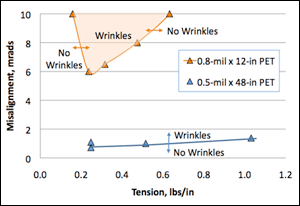Plotting Shear Wrinkles
- Published: August 22, 2011, By By Timothy J. Walker, Contributing Editor
The combined conditions of when roller misalignment is bad enough to wrinkle a web is a complicated mechanism. You have to combine concepts of roller misalignment, web buckling, and web-to-roller traction. As with any engineering challenge, you can use both experiment and mathematical methods to advance your understanding. The advanced modeling techniques are amazing, but some simple experiment techniques can be a great starting point (and you don’t need a fast computer or advance modeling aptitude).
For the single span shear wrinkle test, you need the following:
1) A web line where you know web tension and speed (just about any load-cell controlled zone is a good candidate).
2) A section of the web path with three rollers where the second of the three rollers has a wrap angle of 90 deg, preferably with the first span at least half a web width long, but all spans lengths can prove interesting.
3) A good coefficient of traction on the first of the three rollers, which you can get with a rubber covering or tacky tape wrap. This will make the span more wrinkle-sensitive and prevent our experiment from having interactions between spans.
4) A mechanism to misalign the #2 roller parallel to the entering web, inducing bending in the entry span and twisting in the exit span. Sliding on a pillow block may be good enough, but a fine adjust linear actuator, turnbuckle, or bolt adjustment would be great.
5) A dial indicator, micrometer, or some other way to measure the amount of roller misalignment, and know when it is back to the aligned position.

Just add your web—some you are willing to damage—and you are ready to wrinkle. Start with a known web, speed, and tension, and the rollers aligned. Now misalign the #2 roller, bending the web between rollers 1 and 2 until a wrinkle forms. The shear wrinkle should form on roller #2, forming initially on the loose side of the bending span then walking to the tight side. At this point, you should have a continuous diagonal crease generator.
If you run paper or another brittle material, you may have broken your web. (Consider yourself warned.) Repeat the test at different tensions. Make a table of the minimum roller misalignment to make a wrinkle at each tension. Now you can make a shear wrinkle plot.
The graph is an example of a shear wrinkle plot and includes data from wrinkling narrow and wide thin polyester. The shear wrinkle plots usually graph tension (or strain) on the X-axis and misalignment on the Y-axis. The typical shape of the isolated span shear wrinkles tests will resemble a Nike swoosh. At extremely low tension, it can be difficult to wrinkle when there is insufficient web-roller traction to bend the web or hold the web in the buckles form on the roller. For moderate to high tension, tension stiffening makes the web less wrinkle-sensitive due to tension stiffening.
The data and line on the bottom show a more sensitive wide and thinner web. You might expect thinness is the cause of this sensitivity, but the greater width is the more important factor.
Repeat this experiment with different webs, rollers, web speeds, and span lengths. Before you know it, you will have a number of contour plots showing which of your web and process conditions are the most sensitive to wrinkling.




